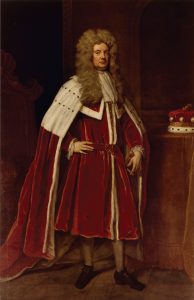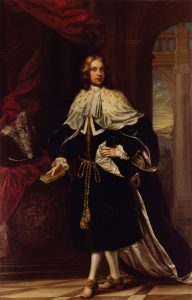- © 2025 Annapolis Home Magazine
- All Rights Reserved

2nd Lord Baltimore, Cecil Calvert (1606-1675)
If you have not visited the historic Maryland State House recently, a trip is worth your while. Full-length portraits of the six Lords Baltimore now hang in the rotunda and the grand staircase. Painted from life by court painters in England between about 1630 and 1765, they form a rare historic and artistic record of colonial Maryland.
The Lords Baltimore—six successive generations of the Calvert family—owned the lands we now call Maryland. In 1632, King Charles I granted to the Calvert family of Yorkshire, England, land north of the Potomac River, south of the 40th latitude and on both sides of
the Chesapeake Bay. Maryland was named for Henrietta Maria, the King’s wife.
George Calvert, the first Lord Baltimore, had held important positions in the court of King James I, was knighted in 1617, and was profoundly interested and involved in the colonization of America.1 Although George was the intended recipient of the land to be granted by the charter, he died before it was approved. Thus, George’s son Cecil, the second Lord Baltimore, received the charter and passed it down to four subsequent generations. This powerful family were the colonial proprietors of the Colony until the American Revolution.
The framed paintings measure approximately 7 feet high by 5 feet wide. They constitute an imposing group of English aristocrats, dressed in finery of their periods.

3rd Lord Baltimore, Charles Calvert (1637-1715)
The portrait of the second Lord Baltimore, Cecil Calvert (1606-75), painted by Gerard Soest in about 1670, has drawn the most attention. In 1933, Burlington Magazine published an article calling the painting a “masterpiece,” and noting the influence of the style of Van Dyck. 2 The painting was included in an exhibition of great British paintings at the Yale Center for British Art in 2001.3 It shows Cecil Calvert with his grandson Cecil Calvert and an unidentified young servant. The only painting of more than one individual, this composition is a three-person tableau of wealth and inheritance. Lord Baltimore is dressed in the colors of his coat-of-arms. His grandson, dressed in the elaborate finery of a very young child, is the heir-apparent to the Colony. The richly-outfitted servant, bowing as he presents a feathered hat, is a further indication of the family’s wealth.
The map of the territory of Maryland held downward by the Lord to allow his grandson to touch it, depicts the domain of the Calvert family and the family’s coat-of-arms. The entire scene symbolizes the assumed eternal hold by the Calvert family on “Terra Mariae.”

4th Lord Baltimore, Benedict Leonard Calvert (1679-1715)
It is remarkable that the series survives in Maryland. We have Dr. Hugh Hampton Young to thank. Dr. Young, a Baltimore physician and student of Maryland history, secured four of them from Sir Thomas Calvert Eden, a Calvert descendant who, had put all six to auction at Sotheby’s in London in 1933. Dr. Young purchased the four that did not sell. He then purchased the fifth portrait from Lord Fairfax of Cameron, a Prince George’s County native. One of the six portraits was missing, though. It was owned by none other than William Randolph Hearst who planned to display it in his oceanside castle. Believing that the portraits belonged in Baltimore, Dr. Young told the Enoch Pratt Free Library that if they acquired the portrait from Mr. Hearst, he would gladly present the other five as a gift. Mr. Hearst agreed to sell the painting and in 1940, Dr. Young donated the paintings to the Library.
The six paintings have hung for more than 80 years in the Central Hall of Pratt’s Central Library building, which is undergoing a comprehensive multiyear renovation. The paintings had to be moved for safe-keeping, and it seemed appropriate that they sojourn for a time in the historic State House among other artifacts of early Maryland. Now on loan, they will eventually return to the city that bears the name of their subjects.
To see all six Lords Baltimore paintings, visit the Maryland State House, 100 State Circle, Annapolis, MD.
1 “The Lords Baltimore: An Account of the Portraits of the Founder and the Five Proprietaries of the Colony of Maryland,” brochure published by The Enoch Pratt Free Library (revised printing, 1961), 2.
2 Tancred Borenius, “Cecil Calvert, Lord Baltimore, by Gerard Soest,” Burlington Magazine lxiii, no. 368 (November 1933): 193.
3 See Julia Marciari Alexander, “Gerard Soest c. 1600-1681,” in Great British Paintings from American Collections: Holbein to Hockney (New Haven: Yale University Press, 2001), 58-61, for a full description of the painting and a note on the painter. Alexander explains that the boy’s father, Charles Calvert, had gone to Maryland as Governor in 1661, but returned with his son to England for a visit in 1669, when this portrait could have been painted. 60.
Virginia K. Adams, Ph.D.
Dr. Adams is an art historian and a Trustee of the Enoch Pratt Free Library.
Annapolis Home Magazine
Vol. 8, No. 6 2017